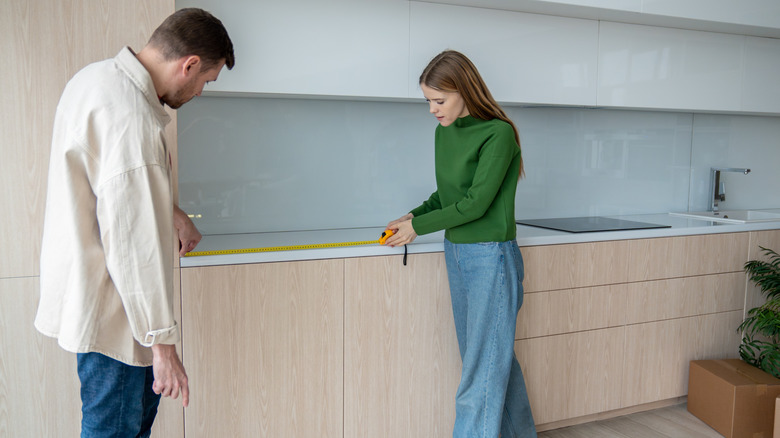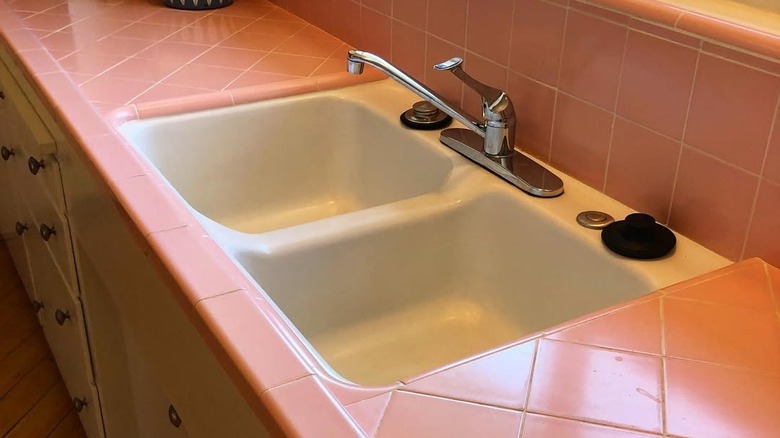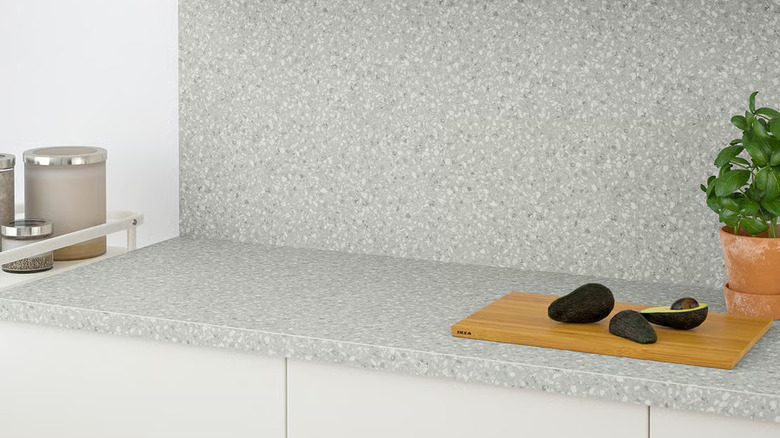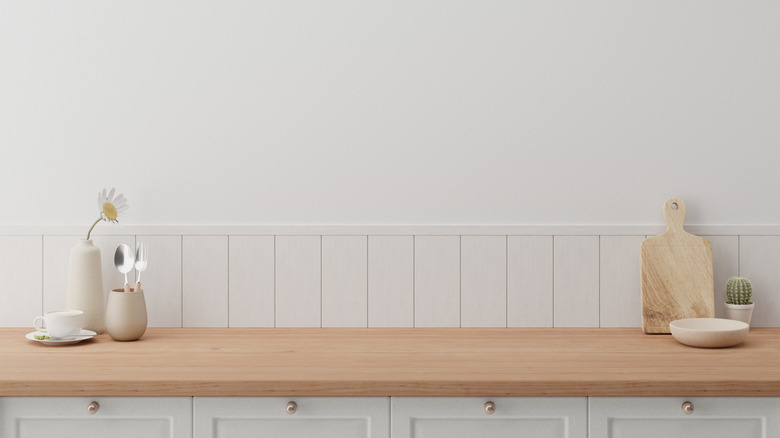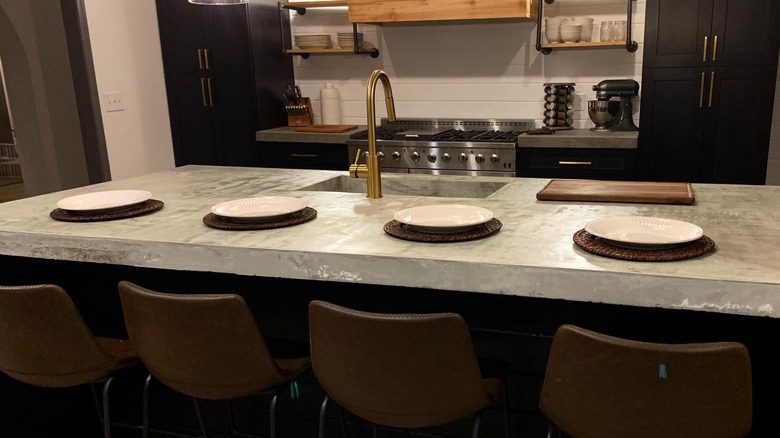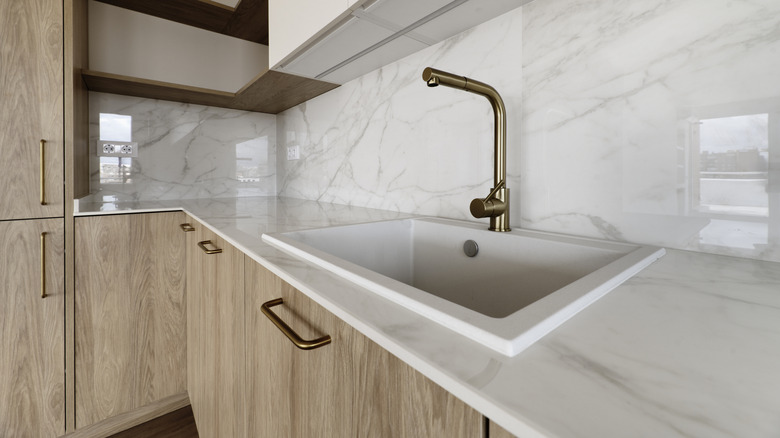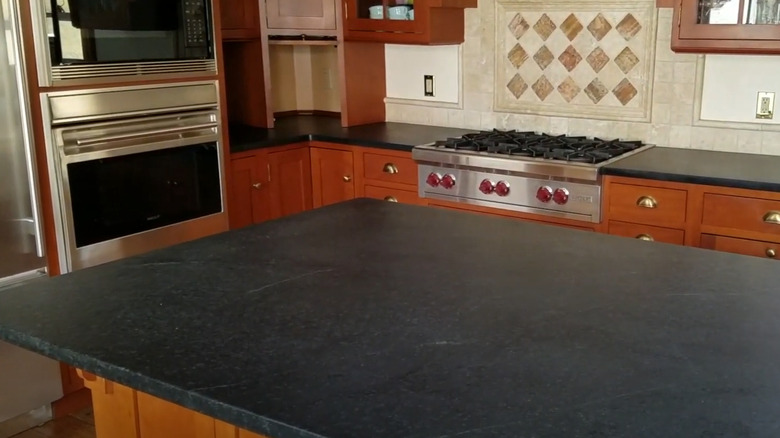6 Of The Most Affordable Kitchen Countertop Materials
We may receive a commission on purchases made from links.
A kitchen countertop should be more than functional. It's the focal point of a kitchen, and you should choose a material that is aesthetically pleasing and practical for everyday use. Many homeowners and landlords seek out materials that are beautiful, resilient, but also don't break the bank. Unfortunately, it can be tricky business to find the right material when you're sticking to a budget. It may be harder to find affordable countertop materials, but there are several out there that are easy to come by.
Below are several countertop materials that are affordable, and installing some of them yourself can also help you stick to your budget. This may seem like a large undertaking, but it can save you some serious cash. With other options, you may have to choose a cheaper brand or avoid stylistic features to reduce the total price. So, learn how much these affordable countertops run, how to cut costs, and whether they're right for your home.
Ceramic tile counters are an affordable '80s trend making a small comeback
Few countertops match the '80s vibe of classic ceramic tiles. These tiles come in many different colors, patterns, and sizes, and there are dozens of budget-friendly options between $0.50 to $3 per square foot. Keep these tiles at their insanely low price by DIYing them yourself and choosing the easiest options. Larger tiles will be less work and require less grout. Pick bevel or bullnose edge designs, which are almost half the price of stylized countertop edges. When it comes to grout, the most cost-effective option is cement, which is also easier to apply than epoxy or other types.
Ceramic tile countertops are inarguably cheap upfront, and there are hundreds of colors and designs to choose from. However, be wary that this retro design can be costly in the long run. Ceramic tiles aren't very durable, and heavy dishes can crack and chip them. Spilled liquids can also stain the grout and fill the porous material with bacteria and germs. Therefore, the countertops need to be cleaned and resealed regularly. It's important to keep in mind that cement grout is cheap, but it potentially deteriorates from exposure to acidic foods.
In short, ceramic tile and concrete grout lines are the most affordable way to add these vintage-style countertops in your home. They are beautiful, but may not be the most practical idea for busy kitchens where families cook and eat every day. Only choose a budget-friendly ceramic tile countertop if you're a big fan of the nostalgic style. If you're looking for a countertop based solely on budget, there are other affordable options that are less tedious to clean and maintain.
Laminate counters come in many designs and colors for a low price
Laminate is the undeniable go-to for budget-friendly countertop materials, and this material is well-known for its affordability and practicality in kitchen settings. It's possible to achieve a high-end kitchen look with laminate countertops, even though the material starts as low as $10 per square foot. When choosing a laminate underlayment, go with plywood rather than MDF since it's around half the cost. With low-cost laminate, a standard finish, standard edging, and a plywood underlayment, a DIY project should cost around $24 per square foot total.
Laminate's smooth surface is easy to clean and maintain, as there are no grout lines to trap dirt and bacteria. It's also fairly lightweight, easy to install, and lasts for decades with proper care. Laminate is a very good material for the price, but it does come with some cons. It isn't heat-resistant and is tough to repair. It can also look visibly cheaper than more expensive stone countertops, especially if the seams between laminate pieces are visible. If you consider your countertop seam placement during the installation, it will look better, but the finished product still likely won't boost your home value.
Engineered butcher block is ultra-budget-friendly, and professional installation is optional
Authentic hardwood butcher block countertops are a pricey investment, but there is an alternative for those on a budget. Many real wood countertops have a cost range of around $25 to over $100 per square foot. However, engineered butcher block countertops come in large slabs and cost around $12 per square foot. Keep installation cheap by taking the DIY route and renting tools from your local hardware store. Many engineered butcher block options already come with a factory finish, so there's no need to purchase wood finish or spend extra time applying and waiting for it to dry. This is more cost-effective and makes DIY engineered butcher block countertops easier than real wood.
While engineered butcher block captures the natural aesthetic of real wood, adding a rustic and nature-inspired touch to kitchens, don't forget about the downsides. Like solid wood countertops, engineered wood countertops aren't heat-resistant, and they're prone to damage and staining from dishes and spills. The solution for fixing real wood is to sand down the countertops and refinish them as needed. However, this plan of action is limited with engineered countertops. The wear layer is much thinner, hence the lower price. So, it can't be refinished over and over like solid wood.
Concrete countertops are DIYable, which can cut down on costs
The materials for concrete countertops run about $5 to $15 a square foot. However, with installation, you'll be looking more in the $50 to $150 per square foot range. So, this is definitely an option where DIYing it is a huge money saver. In short, concrete countertops are budget-friendly as long as you are capable of the manual labor involved. To keep them in good shape, use a relatively cheap but food-grade concrete sealer like H-Seal Concrete Countertop Sealer Matte Finish.
Concrete is a lesser-known kitchen countertop material, and its industrial look isn't for everyone, but it's great for rustic and eclectic kitchens. There are customization options with more pigments, stains, and even stamping, although all of these features increase the price. On the plus side, concrete is resistant to heat and physical damage as long as it's resealed once a year. Hairline cracks can form, but they aren't very noticeable. The main concern with concrete is that it is very heavy, and cabinets and floors need to be able to support the weight of the material. It can be hard for an inexperienced DIYer to determine the weight limits of their cabinets and concrete board, making this a trickier DIY.
Acrylic countertops are cheap but have a seamless quality
Solid surface countertops made from acrylic seem like the best of both worlds; they resemble real stone or wood while being relatively affordable. Depending on the brand, the materials start as low as $20 per square foot. However, popular home improvement retailers like Home Depot and Lowe's primarily sell custom acrylic countertops instead of individual slabs. These countertops still start off cheap compared to other types, costing homeowners about $35 per square foot.
Acrylic gets a bad rap for being associated with plastic, but the material is of higher quality than people realize. Acrylic and resin countertops are highly customizable, seamless, nonporous, and easy to clean and upkeep. If diligently maintained, they last for many years. The main downside is that hot dishes can discolor the surface, so it's essential to always use a hot pad to prevent pots and pans from touching the acrylic. They are relatively weak compared to natural stone, so be careful not to scratch or damage the material.
Budget-friendly soapstone countertops have smooth surfaces with remarkable veining
Soapstone is a natural stone that isn't as well-known as marble and granite. As the name implies, this stone is softer than other minerals, but can be just as beautiful. What you need to know about soapstone countertops is that they're very affordable as far as natural stones go, and the material averages between $20 and $70 per square foot. Most of the cost of building a soapstone countertop comes from the labor costs. Fortunately, this stone doesn't need as many specialized tools as other natural stones. So, installation can be doable on your own with a rented or borrowed circular saw, jigsaw, drill, grinder, and sander.
Don't let the cheap price fool you. Soapstone countertops don't have strong reactions with most acids, heat, and chemicals from cooking, making them a great choice for kitchens. It's generally safe to place hot foods on soapstone. The downside is that because this is a "soft" stone, it scratches more easily than more expensive minerals. Another issue is that soapstone countertops can be discolored by oil. The easy solution is to coat an entire countertop in a protective layer of mineral oil, though this alters the texture and color of the whole slab.
